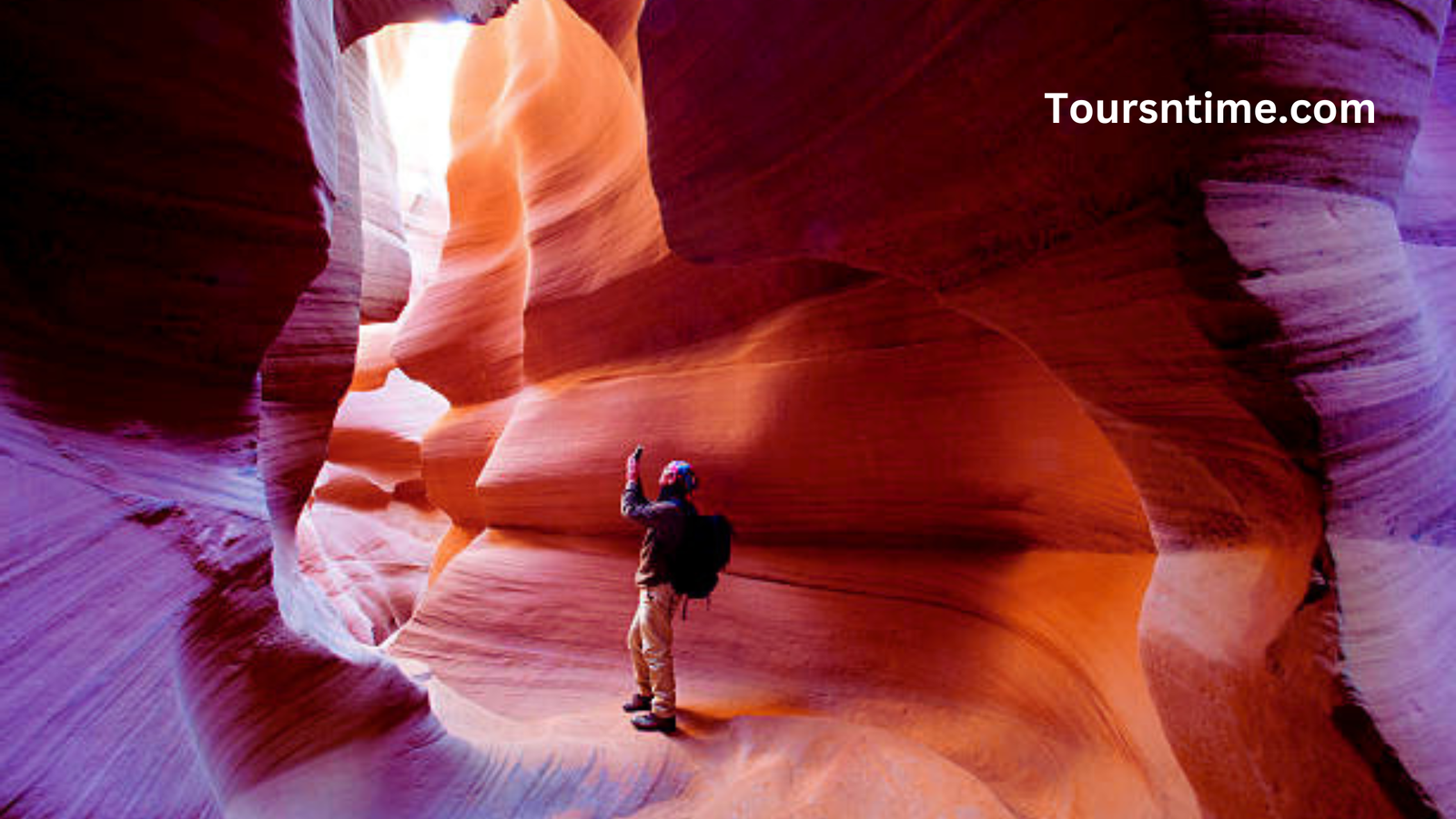Introduction
Located in the coronary heart of the Navajo Nation in northern Arizona, it is one of the most photographed and visited slot canyons in the world. Famous for its cute wave-like rock formations and vibrant colors, Antelope Canyon offers an out-of-this-world experience for nature fanatics, photographers, and adventure seekers. This article examines Antelope Canyon’s geology, facts, vacationers, and environmental impacts, illustrating why it remains a must-see vacation spot.
Geological formation
The captivating beauty of Antelope Canyon is the result of thousands and many years of herbaceous erosion. A canyon is often formed by flash floods and the slow emplacement of water through sandstone, growing slender passages with simple, flowing shapes. The rock formations are broadly composed of Navajo sandstone, a fabric known for its pleasing graininess and susceptibility to erosion, contributing to the canyon’s precise and complicated style.
Upper and Lower Antelope Canyon
Antelope Canyon is divided into separate sections: Upper Antelope Canyon, also called “The Crack,” and Lower Antelope Canyon, called “The Corkscrew.” Upper is more handy and better known among vacationers because of its wonderful, clean roads and the well-known moderate rays that penetrate the canyon at some unspecified time in the future positive cases of the day. Lower Antelope Canyon, while narrower and requiring extra physical agility, offers additional beautiful perspectives and a more intimate level.
Light beams Upper Antelope Canyon
One of Upper Antelope Canyon’s ultimate iconic abilities is the tiny rays that shine down into slender openings, illuminating the walls with an ethereal glow. These mild rays normally appear during the summer months, at the same time when the Sun is at its maximum component in the sky. The interplay of mildness and shade creates a magical setting that makes it a popular spot for photographers seeking to capture the otherworldly beauty of the canyon.
Cultural significance
Antelope Canyon has extensive cultural and non-secular significance to the Navajo, who call it “Tse’ bighanilini,” meaning “the area where the water flows through the rocks.” The canyon is considered a sacred net site, and the Navajo accept as real that the gentle rays are spiritual courses. Visitors are regularly reminded to respect the canyon’s culture and treat it with respect when visiting at an unspecified time in the future.
Visit Antelope Canyon
A guided tour is required to visit, as the canyon is located on Navajo land, and access is restricted to protect its herbal beauty. Several tour organizations provide guided tours of each Upper and Lower Antel and offer information on the geology, records, and website. Tours often include pix tips to help the tour capture the canyon’s adorable visuals.
The best time to visit
A wonderful time to go to Antelope Canyon depends on what you want to enjoy. For the well-known moderate rays in Upper, a remarkable time is between late March and early October, around noon at the same time as the sun. Is suddenly overhead. For less crowds and quieter fun, it is recommended to visit in the direction of the spring and autumn seasons. Lower Antelope Canyon is much, much less crowded and offers beautiful mild 365 days.
Photo opportunities
Antelope Canyon is a photographer’s paradise. Swirling sandstone partitions, converter sunglasses, and dramatic gentle rays offer countless opportunities for beautiful pictures. Whether you’re an amateur with a mobile smartphone or an expert with an over-committed device, the canyon delivers accurate and breathtaking compositions. Many tours are designed especially for photographers, allowing more time and guidance to get the right shot.
Navajo Tours
The Navajo people are the custodians of Antelope Canyon, and the maximum number of trips are conducted with Navajo guides. Now, these courses are not the easiest to navigate the complicated terrain, but they additionally include stories and insights about the canyons and plant data. Their deep connection with the landscape adds an enriching layer to visitors and makes the excursion more than just a visual spectacle.
Safety and environmental considerations
Safety is an important consideration when traveling. The area is prone to flash floods that would occur suddenly and present a prime chance. Tour operators carefully display the weather conditions on the screen and cancel tours in case of danger. In addition, it is recommended that online internet site traffic comply with all conservation recommendations and admire the sensitive surroundings that help maintain the canyon for future generations of destiny.
Attractions nearby
While Antelope Canyon is a huge vacation spot in and of itself, there are several unique sights in the area for traffic to discover. Horseshoe Bend, a dramatic horseshoe bend in the Colorado River, is at its best when it’s fast away, providing delightful panoramic views. Lake Powell, with its extensive water activities, and Glen Canyon Reservoir, are also nearby and worth a visit.
The impact of tourism
Antelope Canyon’s reputation has brought both advantages and disadvantages. Tourism provides excellent economic benefits to the Navajo Nation, helping to close businesses and providing jobs. However, the excessive volume of internet visitors to websites can also strain sensitive environments and infrastructure. Efforts are being made to stabilize tourism with conservation to keep the canyon intact for future generations.
Conservation efforts
Conservation is a top priority for the Navajo Nation and tour operators. There are strict tips to reduce the environmental impact of tourism. Visitors are required to live on specific roads, and the size of the institutions is limited to minimize the canyon. Continued efforts to educate site visitors about the importance of preserving Antelope Canyon’s natural and cultural information are critical to its sustainability.
The magic of Antelope Canyon seasonal changes
Each season brings a unique character. In winter, the reduced angle of sunlight creates deeper shadows and more muted colors, providing an excellent but similarly lovely angle. Spring and autumn offer mild temperatures and colorful colors, and at the same time, summer showcases mild rays. This seasonal pattern ensures that every visit to Antelope Canyon is very special and wonderful.
A geological wonder
Understanding the geologic methods that created Antelope Canyon increases the appreciation of its splendor. Layers of Navajo sandstone, deposited over many thousands of years, tell the story of ancient deserts and shifting sands. Erosion using flash floods and wind created complicated shapes and styles that grew into a natural masterpiece that is constantly evolving.
The sound of silence
One of the most striking features of Antelope Canyon is the profound silence that surrounds the narrow passages. Far from the hustle and bustle of everyday life, the canyon provides a peaceful escape where the whisper of the wind and the occasional trickle of water are exceptional sounds. This tranquility allows site visitors to connect deeply with nature and experience the experience of tranquility and mirrored photos.
The role of light
Light plays a key characteristic in the ever-changing appearance of Antelope Canyon. As the sun moves through the duration of the sky, the perspective and intensity of the moderate trade cast dramatic shadows and illuminate the counters with a spectrum of colors. This dynamic interplay of peace and shadow transforms the canyon during the day, providing new and enchanting views at every turn.
The mystique of Slot Canyon
Slot canyons like Antelope Canyon are slender, deep channels carved into the landscape, regularly with walls that rise excessively. The anxiety of the passages and the top of the walls creates a love affair in thriller and travel. Exploring the hidden passages feels like moving into any other world where nature’s art is in full swing.
Capturing the essence
Photographers traveling to Antelope Canyon often seek to capture its essence through innovative techniques. Long advertising photos can be decorated with the airy splendor of light rays, even as large lenses capture broad curves and complicated textures. Whatever the approach, the reason is to provide the sublime splendor of the canyon and the emotions it inspires.
Road to Antelope Canyon
Reaching Antelope Canyon is an adventure in itself. As a result, the closest metropolis to Page, Arizona, serves as a gateway to the canyon. Visitors often embark on scenic thrills across a wasteland panorama that sets the stage for the stunning splendor that awaits them. The adventure heightens the anticipation, making the primary view of the canyon even more spectacular.
Local community
A close network of Navajos holds a critical position in the management of Antelope Canyon. Their deep understanding of the country and willpower to preserve its natural and cultural background is evident in every issue of the visitor experience. Engaging local people through tours and cultural apps offers a deeper understanding of the canyon’s significance.
Personal considerations
Visiting Antelope Canyon is a deeply private experience for many people. Breathtaking beauty, silence, and connection with nature disappear with lasting effect. Many site visitors have found themselves thinking about the passage of time, the power of herbal forces, and their place in the world. This reflective detail adds a deep measure to the target.
The future of Antelope Canyon
The fate of Antelope Canyon rests on responsible tourism and persistence. As more human beings learn about its beauty, the desire to protect and preserve this herbal wonder becomes even more important. Sustainable practices, training, and collaboration between the Navajo Nation and transportation will ensure that it remains a place of reverence and inspiration for generations to come.
Conclusion
Antelope Canyon is a testament to the beauty and energy of nature. Its beautiful rock formations and colorful sunshades make it a vacation spot no different. By respecting its herbal and cultural historical past, we can ensure that this stylish masterpiece will continue to inspire and captivate all visitors.
Whether you’re drawn to geological wonders or non-secular connections offers unforgettable delights in a wonderful way to stay with you longer than you leave its slender, winding corridors.


